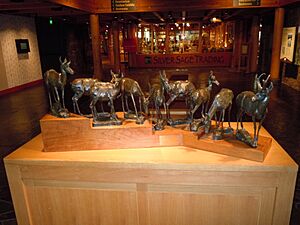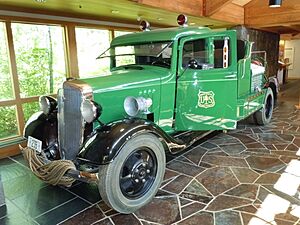High Desert Museum facts for kids

Museum front entrance
|
|
| Lua error in Module:Location_map at line 420: attempt to index field 'wikibase' (a nil value). | |
| Established | 1982 |
|---|---|
| Location | Bend postal address, Oregon, U.S.A. |
| Type | Natural history |
| Collection size | Approximately 30,000 artifacts |
| Visitors | 170,000 per year |
| Founder | Donald M. Kerr |
The High Desert Museum is a cool place to visit near Bend, Oregon, in the United States. It opened in 1982. This museum helps people understand the amazing wildlife, culture, art, and natural resources of North America's high desert region.
You can explore both indoor and outdoor exhibits. See animals living in spaces that look like their natural homes. The museum also has special traveling exhibits and shows that bring history to life. It's a top-notch museum, recognized by the American Alliance of Museums and connected to the famous Smithsonian museums.
Contents
Discovering the Museum's History
The High Desert Museum was started by Donald M. Kerr, who grew up in Portland, Oregon. He loved natural history and wanted to share that passion. In 1974, he created the Western Natural History Institute. The museum grew out of this institute, opening its doors in 1982.
It was first called the Oregon High Desert Museum. Later, its name changed to simply High Desert Museum. This new name showed that it covered the entire high desert region, not just Oregon. The museum sits on a large 135-acre site. When it first opened, it had mostly outdoor exhibits and a small building.
In 1989, the main building got much bigger. A 28,000 square foot addition was built. This helped the museum welcome 100,000 visitors each year. The new part, called the Earle A. Chiles Center, was a gift from the Chiles Foundation. In 1994, the museum started a five-year plan to grow even more.
The museum earned special recognition in 1999. It was accredited by the American Alliance of Museums. By 2016, about 170,000 people visited the museum every year. In 2017, it became a Smithsonian Affiliate institution. This means the museum can borrow artifacts from the Smithsonian. It also gets special traveling exhibits and educational programs. Only three places in Oregon have this special connection to the Smithsonian.
In 2021, the museum received a big honor. It was given the National Medal for Museum and Library Service. This award celebrates museums that make a difference in their communities.
Exploring the Museum's Buildings
The High Desert Museum is located on 135 acres of pine forest. It's south of Bend, Oregon, right off U.S. Route 97. The museum has many indoor and outdoor exhibits. There's also a library, a special "desertarium," and a cafe.
The main entrance is called Schnitzer Hall. From here, you can go straight into the Collins Gallery and the museum gift shop. You can also turn right or left to find other exhibits. To the right is the Earle A. Chiles Center. This area also has galleries for special traveling shows.
To the left of the entrance is the Henry J. Casey Hall of Plateau Indians. The cafe is near the gift shop, and there's a classroom too. If you walk through the Collins Gallery, you'll find an indoor desertarium. This area has living desert animals on display. The exit from the desertarium leads to the Donald M Kerr Birds of Prey Center. This is where you'll find many of the museum's outdoor exhibits.
Amazing Collections and Exhibits
The museum has over 18,500 artifacts in its collections. These include beautiful artworks by famous artists. There are also historical items from Native American cultures. Many Native American pieces come from the Doris Swayze Bounds Collection. Other items show what life was like after people from Europe settled in the region.
What You Can See Inside
The exhibits focus on local culture, natural resources, wildlife, and art. The museum's indoor and outdoor displays are huge. They show Native American life, pioneer history, and amazing animals. You can even walk through a town from the 1860s! It has a blacksmith shop, a Chinese store, and a stagecoach stop.
The Native American exhibit teaches about life before settlers arrived. It also covers life on reservations and modern topics like Indian Casinos. There's a stunning display of horse tack. These items were used for the Pendleton Round-Up. They show incredible craftsmanship and unique designs.
The main museum building is 53,000 square feet. Inside, you can see a Forest Service fire truck. There's also a stagecoach and many Native American history displays. The Hall of Exploration and Settlement shows 100 years of high desert history. You can see scenes like a trapper's camp, a pioneer wagon train, and an old western boomtown.
Outdoor Adventures
Outside the museum, a quarter-mile trail follows a forest stream. It's lined with aspens and ponderosa pines. Along the path, you'll find many exhibits and animal habitats. There are 32,000 square feet of outdoor exhibits.
You can see popular wildlife like three river otters. There are also desert tortoises, a porcupine, and amazing birds of prey. Other outdoor exhibits include a Native American encampment. You can also explore a sawmill from the early 1900s. See old logging equipment, a homesteader's cabin, and a forestry pavilion.
Astronaut Training Exhibit
From July to November 2019, the museum had a special exhibit. It showed how U.S. astronauts trained for the moon. They practiced in central Oregon, near Bend, because the landscape was similar to the moon!
Images for kids













